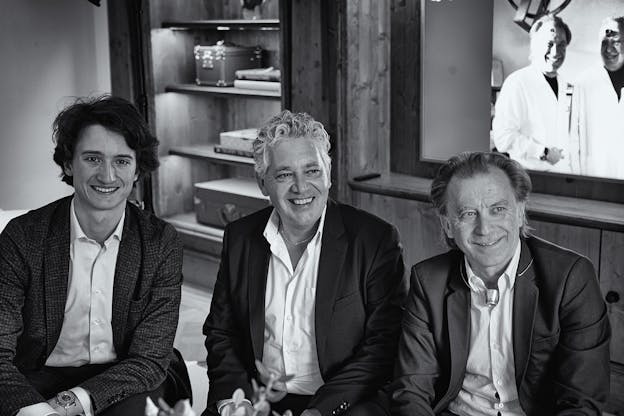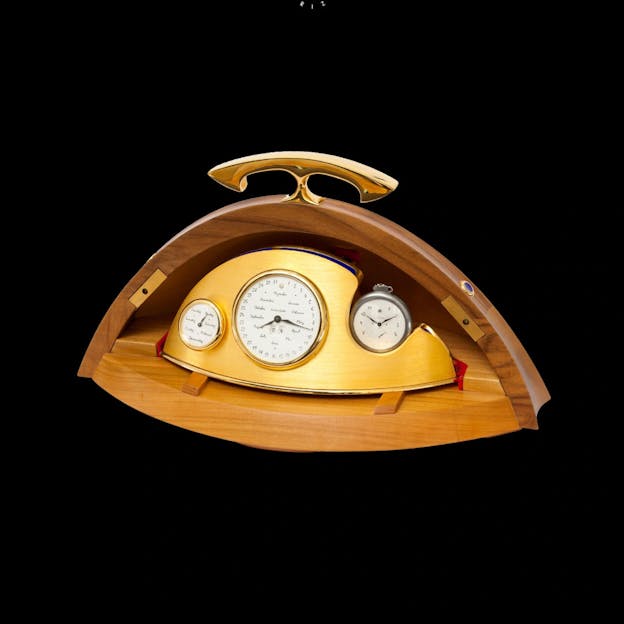Why Two Of The Five Louis Vuitton Watch Prize Finalists Aren’t Wristwatches
Time has many faces.
The Louis Vuitton Watch Prize For Independent Creatives was established to recognize and reward horological and design excellence, as well as work characterized by a spirit of individuality an innovation, in the very large world of independent horology. The world of independent watchmaking has grown by leaps and bounds over the past twenty years, and much of the most interesting and innovative watchmaking now takes place in the workshops of watchmakers whose brands are independently owned and operated, rather than under the roofs of group owned brands, which by their nature tend to be more constrained in how far afield they can go from business as usual.
The Louis Vuitton Watch Prize has a very wide scope. Entry criteria were straightforward. Any candidate for the prize, which includes a cash grand as well as a year of technical, marketing and legal support from Louis Vuitton’s watch manufacturing and design center, La Fabrique du Temps, need only have designed, manufactured, and completed a watch commercially registered prior to July of 2023. The pool of fifty jurors (of which I was one) were responsible for scouting for potential candidates but of course, watchmakers were free to enter on their own as well; it wasn’t necessary to be suggested by a jury member first. The last stage of the LV Watch Prize is now in progress, and five judges from the fifty panel jury have been chosen to decide between five finalist candidates.

The jury members are some of the most experienced, well informed figures in the world of watchmaking. Jiaxian Su, or SJX as he’s known, as the founder of WatchesbySJX, represents the world of horological journalists. Auro Montinari is as highly regarded a collector as one can imagine; Michael Tay is an institution and one of the architects of the modern watch landscape. Rexhep Rexhepi needs no introduction to anyone with the slightest interest in the history of independent watchmaking over the last decade, and Carole Forestier Kapasi is one of the most distinguished and important watch figures in technical watchmaking of the last 20 years.
The five finalists represent an incredibly diverse range of approaches to mechanical horology – and I say “mechanical horology” rather than watchmaking, because two of the five candidates submitted mechanisms which were not, in fact, wristwatches.

The finalists, which were chosen by jury vote, are Andreas Strehler, Peterman Bedat, Raúl Pagès, John-Mikaël Flaux, and Simon Brette. Brette, Pagès and Peterman Bedat are reasonably well known in the small community of collectors of high end independent watchmaking and each of them has submitted a watch which offers interesting and unusual technical features, as well as varying degrees of commitment to beauty in craftsmanship and finishing. The whole idea of the prize is to make available to a promising candidate, resources which they might not otherwise be able to obtain, and to provide an environment within which it might be possible to pursue, free of some of the constant external constraints so often imposed on independents, which restrict the realization of a particular vision.
Each of the candidates would certainly benefit from the Prize but each would benefit in different ways – certainly for all of the candidates I think that the technical facilities at La Fabrique du Temps could, and would, make a considerable difference. Before the winning candidate is chosen, though, I wanted to look at two out of the five whom I thought represented interesting outliers out of the larger field of original candidates.
These are Andreas Strehler, and John-Mikaël Flaux. Strehler was born in 1971 and has been a member of the AHCI since 2000. He began studying watchmaking formally in 1987, and after completing his training in 1991, worked for four years as a prototypist at Renaud & Papi before starting his own company in 1995, and he’s been an independent watchmaker ever since. This means of course that for most of his professional life, he has worked for no one but himself, although you could hardly ask for a better introduction to complicated watchmaking than a stint at Renaud & Papi, whose alumni include Carole Forestier Kasapi, Stephen Greubel and Robert Forsey, Lange & Söhne’s Anthony de Haas, and the Grönefeld brothers. He has specialized in very small batch complicated watchmaking, and among his achievements is the world’s most precise moonphase watch – the Lune Exacte, which is accurate to one day in two million years.


Strehler’s candidate piece for the LV Watch Prize is his Tischkalendar. The name is straightforward – it means, simply, “desk calendar” although the Tischkalendar is one of the most elaborate desk calendars ever made. It consists of a pocket watch, which docks with a cradle containing a perpetual calendar mechanism. Strehler describes its basic functions: “A pocket-watch displaying the time is inserted into the desk calendar unit which is, in fact, a perpetual calendar. Once the owner goes away from his desk, he takes the pocket watch with him. The desk calendar stops. Once the owner returns to his desk after some days or weeks, he inserts the pocket watch into the desk calendar. The desk calendar knows how long the owner was absent and sets the date right. It has a mechanical memory.”
Strehler’s made a video explaining the workings of the Tischkalendar in greater detail.
This is quite obviously not a conventional wristwatch in any sense – as we’ve said, it’s not a wristwatch at all – but it is an ingenious mechanism and the design has been implemented in quite a beautiful way.
John-Mikaël Flaux began his career more recently – born in 1990, he graduated from the Edgard Faure Watchmaking School in France, and his workshop isn’t in Switzerland, but rather, in Besançon, which is just to the northwest of the French-Swiss border, and which is also a traditional home of French watch and clock-making. A member of the AHCI since 2021, he began his career working in the major complications department of Ulysse Nardin, but created his first personal horological project – a clock in the shape of a wasp, called, logically enough, La Guêpe (“The Wasp”) and then opened his own studio in 2021.

His candidate project for the LV Watch Prize is, continuing the theme of mechanical members of the order Hymenoptera, called L’Abeille (“The Bee”). L’Abeille consists of a clock mechanism, in the shape of a bee with a quite menacing looking stinger – the body of the bee contains the mainspring, going train, escapement, balance and balance spring, and is key-wound, like an old-fashioned pocket watch. You wind the Bee and then place it on its base, where it rotates around a fixed central wheel – come to think of it, in the same way that a tourbillon cage rotates around a fixed fourth wheel. The body of the Bee rotates once every twelve hours, with the stinger acting as the hour hand. I suppose that the clock is actually a kind of tourbillon, albeit a twelve-hour tourbillon.
Both of these projects are a very successful combination of design and mechanical complexity and I think that for both of these horologists, the Prize has already served a certain purpose in bringing a wider audience to some extremely interesting work. A case in point is the Tischkalendar, which Strehler finished in 1998, and which I think it’s safe to say, has flown well under our collective horological radar ever since. Each of the candidate watchmakers and watches have their unique points of interest, and I think that the fact that out of the dozens of watches proposed, we ended up with a group of five finalists two of which are not wristwatches at all, speaks to the diversity of the candidates as well as the wide range of tastes of the larger jury.
Each of the finalists would benefit from the prize but I think each would benefit in different ways, although there’s no doubt that any of the candidates would probably find that the technical resources of La Fabrique du Temps would offer greater scope for research and development, and that financial support could offer opportunities in everything from refining movement design and finishing, to experimenting with advances in technical watchmaking. This coming February, the winner of the Prize will be announced in Paris, but each of the finalists represent such highly individualistic and idiosyncratic approaches to watchmaking that we don’t have to wait until a winner’s chose to appreciate the enormous variety that the finalists represent. It’s easy to feel nowadays that horological creativity is at low ebb, but if the LV Watch Prize has proven anything at this point, it’s that there’s plenty of creativity out there, if you know where to look.

